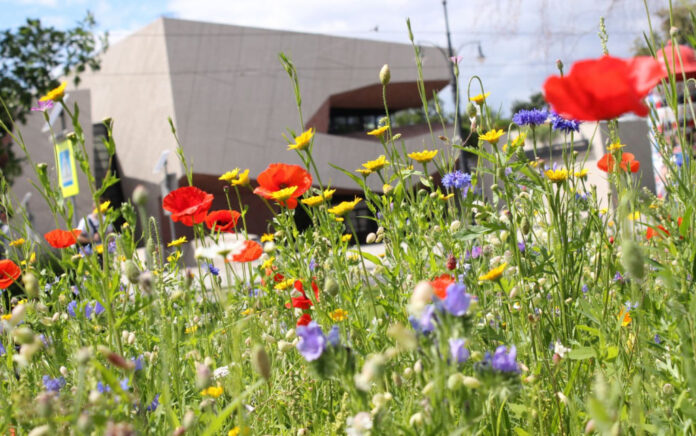They are colourful, fresh and wild. They do not require much attention. They are easy to sow and keep. They are an alternative to expensive lawns. They are an antidote to drought and a way to have a cleaner environment. They foster the protection of biodiversity, which is strongly correlated with climate protection. As a result, the environment becomes richer and more beautiful. It is also considerably more resistant to progressive climate change.
Although sowing has become a fashion trend, „fashion” can sound like a whim or a fad, and yet we understand that more often it is a necessity, an expression of common sense and responsibility.
At present, over 23 million people live in cities. This means 60% of Poles. Life concentrates in cities. This, in turn, causes cities to consume more energy, the consumption of which has been increasing in Poland for years. Office buildings, medium-sized factories, shopping malls and hotels, as well as houses and apartments generate this growth.
Flower-rich meadows in public spaces save both time and energy. They reduce the cost of mowing because they only need to be mowed twice a year at most. They do not need fertilizing, watering or other care treatments either.
Cities also have a concentration of other challenges that require firm and urgent action. They relate to both poor air quality and water scarcity due to long periods of drought. Cities surrounded by concrete and smog quickly become unbearable with drought and high temperatures. Experts argue that meadows lower the temperature in the city. Sown between busy streets, they also have an anti-smog function. Meadows do not require a large amount of water. They should be watered only during periods of extreme drought. According to specialists, as much as 80% of lawns in cities can be turned into flower-rich meadows.

One of the most important reasons why you should take to flower meadows is undoubtedly a high water retention capacity of plants growing in such areas. Their root system is longer – up to 25 times! – and more developed than that of grass. As a result, when it rains, even heavily, meadows absorb much more water. Thus, we don’t have to water them precisely because they have the ability to store water. This is extremely important when, as in June this year, intense rainfall and flash floods occurred. Due to climate change, such events will occur more frequently. Cities made of concrete are particularly vulnerable – there is simply no way for water to drain away. Retention systems and more green areas are the solution. Water retention also means a lower temperature in the city. High vegetation provides protection against the so-called heat island effect. This can cause the temperature in the city to be even several degrees higher than its surrounding rural areas. This is the effect of walls absorbing heat and sunburnt lawns.
Meadows are also a very important element of nature, an element that is important in maintaining biodiversity. They protect the environment, regulate biochemical cycles and facilitate the accumulation of organic substances in the soil. They protect air and water against pollution
Meadows are natural habitats for many species of animals and insects. According to specialists, they can provide a shelter for up to 300 species of animals – small mammals, reptiles, amphibians, insects, including pollinating insects. And these are not only bees, although they, along with bumblebees, pollinate the most flowers. In nature, most species of bumblebees live underground. They often inhabit burrows abandoned by rodents and mole corridors. Meadows therefore create a natural living environment for them.

Mason bees also like the neighbourhood of people. They do not live in swarms, but alone. They inhabit empty stems, holes in wood, crevices. Plants are also pollinated by beetles, flies and butterflies. Meadows are their breeding ground and shelter.
The fact that meadows can create up to 60 species of various plants makes them not only unique ecosystems, but also a unique urban landscape. Thanks to them, the environment takes on an idyllic character and becomes a place of recreation. Due to a huge variety of colours of blooming flowers, the appearance of the meadows changes dynamically with seasons. Thus, meadows not only affect the comfort of life, but thanks to smells and the play of colours, they also soothe emotions.
Flowery meadows are ecological. They create a better microclimate. They filter rainwater and air, including retention of dust, which forms smog.
1 m² of a flower-rich meadow holds 3 g of pollution – as much as a small urban tree! They do not need complicated fertilizers or plant protection products either. They favour farmers, fruit growers and beekeepers. Due to the presence of predators and parasites, if sown next to crops, they affect biological pest control. Moreover, species-rich grasslands in bloom, such as nectar-giving fallow fields, flower field margins, or headland, cause a significant increase in biodiversity, while contributing to an increase in income.
Where can you create blossoming meadows? Anywhere really. In pots on a balcony, terrace, garden, or large areas, squares, green belts, by rails of tramways.
The world is preparing for climate change – cities are looking for effective ways to reduce its negative effects. Meadows are one such way. Meadows have been sown in Polish cities for several years. This Is the case, among others, of Kraków where flower-rich urban meadows are part of the city’s official anti-smog strategy. This year, the authorities of Kraków decided to sow almost 600 kilograms of seeds, thanks to which 29 hectares will bloom on Krakow’s meadows, boulevards and roadsides! Over 20 hectares of meadows are already blooming in Łódź, just like in Warsaw, where there are also flowerbeds with annual plants, or lawns converted into perennial beds. In Katowice, 5 hectares of urban green areas will be dedicated to wildflowers. Similar again in Wrocław, where it was possible to set up a total of about 2 ha of meadows. Meadows also bloomed in Kielce, Lublin, Bialystok, Radom, Rybnik Sanok, Wąbrzeźno, Bielsko-Biała, Starachowice, Zamość, Biała-Podlaska, Oleśnica, Zielona Góra, Jarocin and the Szydłowo Commune, which initiated #KwietnyChallange! Let us hope that the example of local government heads will also be followed by residents and instead of sowing grass in gardens and allotments, they will choose wildflower mixes.

Grasses and meadows keep moisture in the city, which is why the Capital’s Greenery Authority has increased the area of land where mowing takes place once or twice a year. The current weather conditions allow for single mowing of 80 hectares of green areas. (…) This year the Greenery Authority for the Capital City of Warsaw is planning to mow just 3 times in its areas, because more frequent cutting of plants leads to grass and topsoil drying. Balanced care prevents excessive water evaporation. We work according to the standards of greenery care in urban areas. Already last year, due to lack of rainfall, the Warsaw City Hall sent a request for rational grass cutting to the mayors of districts and directors of the capital’s units managing the capital’s greenery.
We hope that the estate administrators and other managers of private areas will also take the current weather conditions into account while taking care of vegetation.
In places with higher moisture, gardeners leave natural meadows – they can be seen in Warsaw parks, squares and roadside rights-of-way, e.g. in Skaryszewski Park, Pole Mokotowskie, Arkadia Park, on the slope of the Marie Skłodowska-Curie Bridge or the belt between the lanes at al. Żwirki i Wigury. The local gardeners also leave the area without mowing throughout the growing season – mowing takes place at the end of autumn.

Flower-rich urban meadows have been functioning in the capital for at least four years. In 2019, in national, voivodship and poviat roadsides we had:
• 13,557 m2 of flower-rich meadows,
• 2 259 m2 of flowerbeds with annual plants,
• 240,000 m2 of natural meadows – areas to be mown once in autumn,
• 30,000 m2 of lawns converted into perennial flower beds.
Last year, we continued to create flower meadows in the parks. The works included:
• Pole Mokotowskie Park 1,000 m2,
• Praski Park 400 m2,
• Kazimierzowski Park 1,200 m2,
In addition, we implement flower meadow projects from the civic budget – that’s how in 2019 more areas with wild flowers were created in Białołęka, Mokotów, Wawer and Ochota. In May 2020, we started modernizing the Michałowski Park, where another flower-rich meadow will also be created. It is impossible, however, to provide total coverage with flower-rich meadows in Warsaw due to a large number of entities and institutions carrying out flower projects – these are both gardeners from the Greenery Authority, offices of 18 districts of capital and municipal institutions of culture, sport and recreation, as well as educational establishments and private entrepreneurs
What plants should I choose for a flower-rich meadow?
The flower-rich meadow is a broad concept. Traditionally, it is associated with grass fields romantically swaying in the wind, enriching the countryside of olden days. However, a flower meadow, defined as a rich and diverse community of herbaceous plants and grasses, is much more than that. Fields of wild flowers address a number of current problems related to climate or loss of biodiversity. They also provide a number of other real benefits, which are so numerous that it is difficult to list them all – comments Karol Podyma – botanist, gardener, specialist in flower-rich meadows, Łąki Kwietne, www.lakikwietne.pl.

Flower-rich urban meadows mean primarily savings in the budget for administrators of green areas, as well as counteracting the effects of climate change, such as prolonged drought periods, urban heat islands or heavy and torrential rains. They also help clean the air of traffic pollution. They build a positive image, increasingly crucial for development. Due to difficult urban conditions (often degraded and dry soil), we mainly use perennial native species that, with proper care, are an investment for years, and bring greater benefits with each subsequent year. Seed mixes are enriched with annual weeds that bloom quickly and intensively, and as a result they arouse feelings and interest in inhabitants.
Owners of sunny balconies, terraces and window sills are advised to make mini meadows – colourful biodiversity hotspots in pots.
Such small meadows support dying pollinators and give a lot of fun to amateur gardeners. You just make sure that the pot does not dry out too much, and the strength of the seeds does the rest. Within 2-3 months useful flowers grow, the cultivation of which from a seed gives a lot of satisfaction. Direct contact with soil makes you even more happy, as evidenced by scientific research.
We choose quickly flowering and easy-to-grow annual species for pots. These are seeds of Polish wild flowers, as well as ornamental and crop species rich in pollen and nectar. In larger containers, you can also create a composition from perennial species that do not require annual reproduction and repeat flowering twice during the season.
Completely different factors are crucial in rural areas – here the benefits that may result in real profits count. Flowery field margins, i.e. intensively flowering headland sown with useful plants, mean above all higher yields and support for biological protection of crops and pollinators. They are also elements of buffer zones limiting the penetration of harmful chemicals leached from fields. They counteract wind erosion, which depletes and destroys land, and also store valuable water in the soil.
As for flowery field margins, we use economical mixes consisting mainly of flowering crop plants enriched with environmentally valuable wild species. We choose mixes with a large proportion of papilionaceous plants, which additionally fertilize and improve soil structure.








